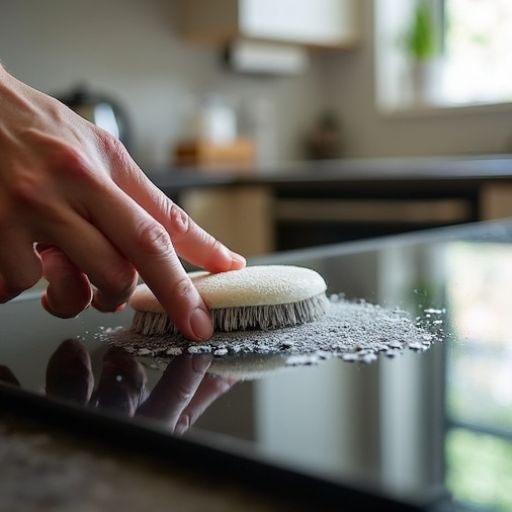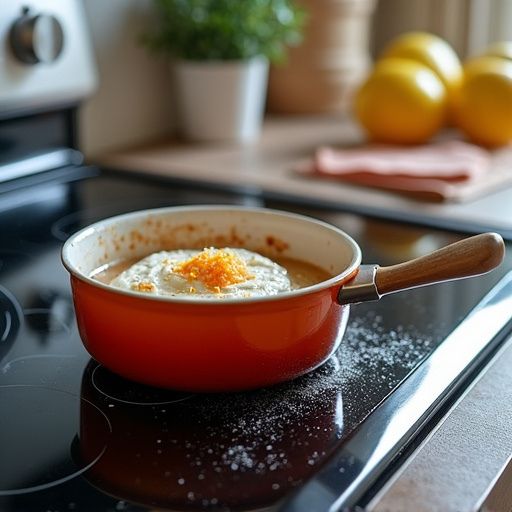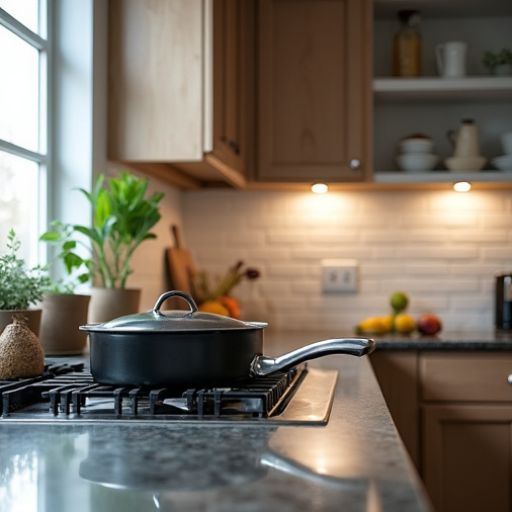15 Ways You’re Permanently Damaging Your Glass Stovetop (Fix #8 Now!)
Your glass stovetop is more than just a sleek cooking surface – it’s an investment that requires proper care to maintain its beauty and functionality.
While you might think you’re treating it well, there’s a good chance you’re making some common mistakes that could lead to permanent damage.
From using the wrong cleaning products to mishandling cookware, these seemingly harmless habits can result in costly repairs or even complete replacement.
If you’ve noticed scratches, discoloration, or performance issues with your stovetop, you’ll want to discover which of these 15 damaging behaviors you might be guilty of, especially number 8, which surprises most homeowners.

Using Abrasive Cleaning Products
Many abrasive cleaning products can permanently scratch or damage your glass stovetop’s delicate surface.
Harsh scouring pads, steel wool, and powdered cleaners contain microscopic particles that create tiny scratches, eventually dulling your stovetop’s shine and compromising its integrity.
These scratches also make future cleaning more difficult as food particles get trapped in the grooves.
Instead, opt for non-abrasive cleaning solutions specifically designed for glass cooktops.
You’ll want to use soft microfiber cloths or special cellulose sponges that won’t scratch.
If you’re dealing with stubborn stains, try a razor blade scraper held at a 45-degree angle to gently remove burned-on residue.
For daily cleaning, a mixture of white vinegar and water in a spray bottle works effectively without risking damage to your stovetop’s surface.
Sliding Heavy Pots and Pans

A common but destructive habit that can ruin your glass stovetop is sliding cookware across its surface.
When you drag heavy pots and pans, their bases can leave permanent scratches and even create micro-fractures in the glass-ceramic material.
Over time, these seemingly minor marks become weak points that may lead to costly cracks or complete surface failure.
Instead of sliding, you’ll want to lift your cookware completely off the surface when moving it.
If a pot’s too heavy to lift safely, let it cool first, then use both hands with proper support underneath.
For extra protection, check your cookware’s bases regularly for rough spots or buildup that could scratch the surface.
Replace any pots with damaged bottoms, and consider investing in lightweight, smooth-bottomed alternatives that you can easily lift.
Neglecting Spills and Stains
One of the quickest ways to compromise your glass stovetop’s integrity is letting spills and stains sit untreated.
When food debris, especially sugary substances or acidic liquids, burns onto the surface, they can create permanent etch marks or pitting in the glass.
These marks won’t just affect your stovetop’s appearance – they’ll create uneven heating surfaces and make future cleaning more challenging.
Don’t wait until your cooktop has completely cooled to tackle spills. Instead, use a damp cloth to wipe up messes as soon as it’s safe to do so.
For stubborn, dried-on residue, use a razor scraper specifically designed for glass cooktops at a 45-degree angle.
Tackle protein-based spills immediately, as they’ll become more difficult to remove once they’ve bonded with the surface.
Wrong Cleaning Tools

Selecting incorrect cleaning tools can undo all your careful spill management efforts.
Steel wool, abrasive scrubbers, and metal scrapers will permanently scratch your glass cooktop’s surface creating grooves where food particles can accumulate and burn.
These scratches also weaken the glass, making it more susceptible to cracking under temperature changes.
You’ll want to stick with soft, non-abrasive cleaning tools specifically designed for glass surfaces.
Use a microfiber cloth or soft sponge for daily cleaning, and invest in a razor blade scraper made specifically for glass cooktops for stubborn residue.
When using the scraper, hold it at a 45-degree angle and work carefully to avoid gouging.
Never use rough brushes, scouring pads, or any cleaning tools with metal components that could mar the surface.
Storing Items On Cooktop
Many homeowners mistakenly treat their glass cooktop as a convenient storage surface, but placing items directly on it can lead to severe damage.
Even lightweight objects like salt shakers or cooking utensils can scratch the surface when moved or shifted.
Heavier items, such as pots, pans, or small appliances, create concentrated pressure points that weaken the glass over time.
You’ll want to keep your cooktop completely clear of any items, even when it’s not in use.
If storage space is limited in your kitchen, consider installing wall-mounted racks, magnetic strips, or overhead pot hangers.
These alternatives protect your investment while maintaining easy access to your cooking essentials.
Cooking With Damaged Cookware

Using damaged cookware on a glass stovetop poses three significant risks to your cooking surface.
First, warped or dented pan bottoms won’t make proper contact with the heating element, reducing cooking efficiency and potentially causing hot spots that can crack your stovetop.
Second, pots and pans with rough or damaged bottoms can scratch and permanently mar the glass surface.
Third, cookware with loose handles or damaged sides might tip over, causing impacts that could shatter your cooktop.
Don’t risk your investment by using compromised cookware.
Inspect your pots and pans regularly for signs of damage, including warping, roughness, or loose components.
Replace any items that aren’t perfectly flat on the bottom or show signs of wear.
You’ll protect your stovetop and guarantee even heating distribution for better cooking results.
Ignoring Minor Surface Scratches
Despite their seemingly harmless appearance, minor scratches on your glass stovetop can develop into serious problems when left unchecked.
These small abrasions create weak points in the glass surface, making it more susceptible to thermal shock and deep cracking when exposed to extreme temperature changes.
Don’t wait for scratches to worsen – tackle them immediately with a glass stovetop repair kit.
These kits typically contain specialized polishing compounds and buffing tools designed to smooth out surface imperfections.
For best results, apply the compound in circular motions, working from the scratch’s outer edges toward its center.
After treatment, seal the repaired area with a protective coating to prevent future damage.
If you’re dealing with deeper scratches that catch your fingernail, it’s time to consult a professional repair service before the damage becomes irreversible.
Using Sugar-Based Ingredients Carelessly

Sugar-based ingredients can spell disaster for your glass stovetop if they spill over during cooking.
When sugary substances like jams, syrups, or candies make contact with the hot surface, they’ll immediately begin to caramelize and bond with the glass.
This creates a stubborn, hardened residue that’s extremely difficult to remove without damaging the cooktop’s surface.
To protect your stovetop, always use pots and pans that are one size larger than needed when cooking with sugar-based ingredients.
Keep a close eye on items that tend to bubble up, such as preserves or maple syrup.
If a spill occurs, don’t wait – immediately turn off the heat and let the surface cool completely.
Once cooled, use a specialized glass stovetop cleaner and a razor scraper specifically designed for ceramic surfaces to carefully remove the residue.
Cleaning While Surface Remains Hot
Just as sugar-based spills require careful handling, attempting to clean a hot glass stovetop can lead to severe damage.
When you apply cleaning solutions to a heated surface, they’ll evaporate rapidly, leaving behind concentrated residue that can bond permanently to the glass.
Even worse, the sudden temperature change between your cleaning cloth and the hot surface can cause the glass to crack or shatter.
You’ll protect your stovetop by waiting until it’s completely cool before cleaning.
The indicator light should be off, and you shouldn’t feel any warmth when holding your hand several inches above the surface.
Once cooled, you’re free to use your preferred cleaning solution without risking thermal shock damage.
This patience prevents costly repairs and maintains your stovetop’s pristine appearance.
Dropping Heavy Kitchen Objects

One of the most destructive risks to a glass stovetop comes from heavy cookware and kitchen tools falling onto its surface.
A single drop of a cast iron skillet, Dutch oven, or heavy pot can instantly crack or shatter your cooktop, leading to costly repairs or full replacement.
To protect your investment, always maintain a designated safe zone for heavy cookware on your counter, positioned away from the stovetop’s edge.
Don’t store items in overhead cabinets directly above your cooktop.
When moving heavy pots and pans, lift them straight up rather than sliding or dragging them across the surface.
If you’re working with multiple items, keep unused cookware on a separate counter to minimize the risk of accidental impacts.
Consider installing a pot rack to keep heavy items safely stored away from your glass cooktop.
Improper Cookware Size Selection
Selecting properly sized cookware is critical for maintaining your glass stovetop’s integrity and performance.
You’ll want to match your pot or pan’s base diameter to the heating element’s size, ensuring no more than a half-inch overhang or underhang on any side.
When you use cookware that’s too small, heat radiates beyond the pan’s bottom, potentially damaging the glass surface and wasting energy.
Oversized pots can create hot spots, trap heat, and cause stress fractures in your stovetop.
They’ll also heat unevenly, compromising your cooking results.
Measure your burner diameters and keep those measurements handy.
For round burners, choose cookware that’s within 1-2 inches of the heating element’s size.
For oval or rectangular zones, stick to specialized cookware designed for those specific shapes.
Harsh Chemical Cleaners

While cleaning your glass stovetop regularly is essential, using harsh chemical cleaners can permanently damage or etch the surface.
Avoid ammonia-based products, bleach solutions, and abrasive cleaners containing chlorine or heavy chemicals, as these can strip away the protective coating and create permanent clouding or discoloration.
Instead, opt for specialized glass stovetop cleaners or create your own gentle solution using white vinegar and baking soda.
You’ll maintain your stovetop’s integrity by applying these milder alternatives with a soft microfiber cloth or non-abrasive sponge.
If you’re dealing with stubborn stains, don’t resort to steel wool or scouring pads – use a plastic scraper designed specifically for glass surfaces.
Remember to always test new cleaning products on a small, inconspicuous area first to verify they won’t cause damage.
Metal Scouring Pads
Metal scouring pads can spell disaster for your glass stovetop’s delicate surface.
The steel wool and metal mesh materials contain abrasive fibers that will permanently scratch and mar your cooktop’s smooth finish, leaving behind unsightly marks that can’t be buffed out.
Instead of reaching for metal scrubbers, opt for non-abrasive alternatives like microfiber cloths, soft sponges, or specialized silicone scrubbers designed specifically for glass surfaces.
You’ll maintain your stovetop’s pristine appearance while still effectively removing stuck-on food and grease.
For stubborn residue, apply a paste of baking soda and water, let it sit for 15 minutes, then wipe clean with a soft cloth.
Don’t compromise your stovetop’s integrity by using harsh metal tools – once you’ve scratched the surface, there’s no going back to its original condition.
Placing Frozen Foods Directly

Frozen food’s rapid temperature change can wreak havoc on your glass stovetop’s surface.
When you place frozen items directly on the cooktop, the extreme temperature differential between the frozen object and the room-temperature glass creates thermal shock.
This sudden stress can lead to microscopic fractures that eventually develop into visible cracks or complete surface failure.
Don’t risk your stovetop’s integrity by using it as a temporary resting place for frozen packages or ice-covered containers.
Instead, designate a heat-safe counter space or cutting board for thawing items.
If you’re transferring frozen ingredients to a pot, hold the container above the stovetop surface and drop the contents in carefully.
This simple habit will protect your investment and prevent costly repairs or full replacement of your glass cooktop.
Wrong Heat Settings
Just as temperature shock from frozen items can damage your stovetop, incorrect heat settings pose another significant risk to glass cooking surfaces.
Your glass cooktop isn’t designed to withstand extreme temperature fluctuations, especially when you crank the heat from zero to high immediately.
Start your burners on medium-low for 30 seconds before adjusting to higher settings. This gradual approach prevents thermal stress on the glass.
Don’t leave empty cookware on high heat, as it can create hot spots that may crack your cooktop.
For boiling water or high-heat cooking, increase temperature incrementally every 30 seconds until you reach the desired setting.
When you’re done cooking, turn the heat off completely rather than switching directly from high to low.
These practices help maintain your cooktop’s integrity and extend its lifespan.
FAQs
Can I Use Specialty Glass Stovetop Covers When Not in Use?
You can use specialty glass stovetop covers when the surface is completely cool, but make certain they’re non-abrasive and designed specifically for your model to prevent scratches and maintain proper ventilation during storage.
How Long Should I Wait Before Replacing a Glass Stovetop?
Like clockwork, you’ll need to assess your stovetop’s condition. Replace it if you’re seeing deep scratches, cracks, or performance issues. Most glass stovetops last 13-15 years with proper care and maintenance.
Does Homeowner’s Insurance Typically Cover Glass Stovetop Damage?
Your homeowner’s insurance will typically cover glass stovetop damage if it’s sudden and accidental, but not wear-and-tear. You’ll need to check your policy’s deductible and specific coverage details before filing a claim.
Can Professional Restoration Remove Deep Scratches From Glass Stovetops?
Like trying to buff out a deep canyon, professional restoration can only partially improve severe glass stovetop scratches. You’ll need specialized diamond polishing compounds, but deep gouges often remain visible despite professional treatment.
What Temperature Differences Can a Glass Stovetop Safely Handle?
You’ll want to keep temperature changes under 100°F (37°C) between your stovetop’s surface and cookware. Don’t place frozen items directly on hot glass or ice-cold water on warm surfaces to prevent thermal shock damage.
Final Thoughts
Your glass stovetop’s a delicate garden – treat it with care and it’ll bloom, neglect it and it’ll wither.
You’re now equipped with essential maintenance techniques to prevent permanent damage.
Wipe spills immediately, use proper cleaning tools, and maintain correct heat settings.
Like a skilled gardener, you’ll need to consistently protect your investment against scratches, etches, and stains.
Remember: today’s maintenance prevents tomorrow’s costly replacements.